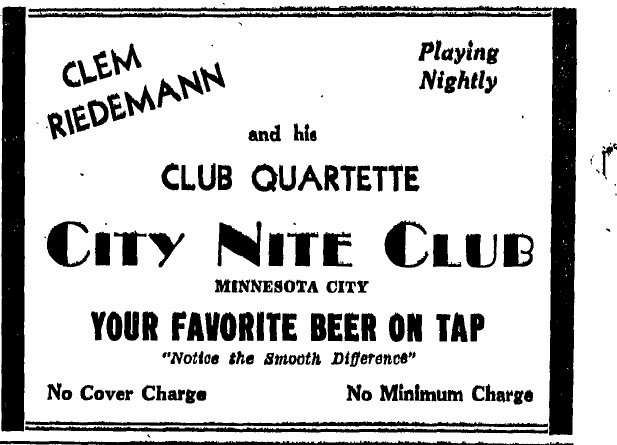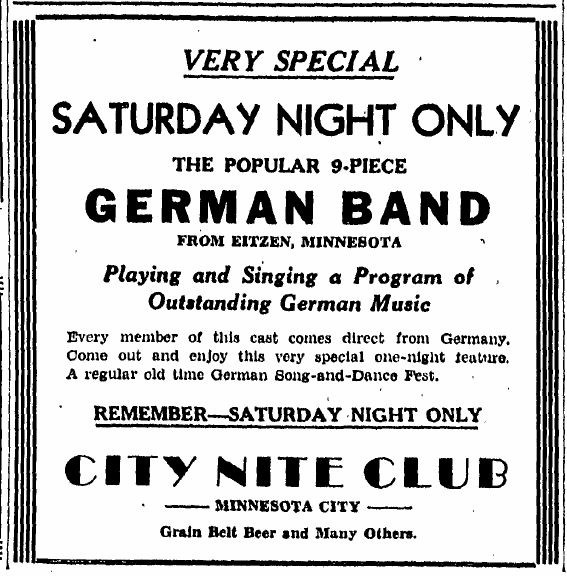City Nite Club

Excepts from the October 2009 MCHA newsletter:
"Through advertisements of entertainment in local media and news articles describing altercations and events at the Club, the spot's fame is clear; the buildings recorded history reflects its dynamic role in the life of many residents of the city."
"The first recorded ownership of the building was by O. M. Lord in 1855. Newspaper research reveals application after application for liquor licenses for the building by familiar and unfamiliar names, ad upon ad for food features and entertainment at the club. Narratives recount adventures of efforts to outwit the law at the club as well as efforts to help the law."
"In 1936, the proprietor of the Club, Adolph Rolbiecki, was arraigned in municipal court on charges of maintaining gambling devices. These included a dime slot machine and a nickel slot machine. Both were seized by the sheriff and were held at the county jail. "He got my machines," Rolbiecki said following his arraignment, "But the county is full of them." The Rolbiecki machines were the first seized by Sheriff Selling in several months, although previously many machines had been seized both in and out of the city of Winona and the defendants sentenced to pay fines up to $200.00" (Winona Republican Herald June 1, 1936).

"In 1943, violations of liquor laws described in the Winona Republican Herald included the arrest of Dolly Brose, Minnesota City Nite Club employee, who was charged with service liquor after the 2:30 closing time. She was arraigned before Justice of the Peace Leo Richter and sentenced to pay a fine of $25.00. City Nite club was owned by Mrs. Julius Pellowski at the time." (Feb 25,1943).
"When The Oaks burned in 1946, Chef Walter Kelly published an annoucement in the WInona Republican Herald of the restaurants temporary relocation in the City Nite Club. the description included this information: "The building we are now occupying (City Nite Club) has been competely checked by competent persons and is capable of handling the capacity to which it is limited by its size. Fire escapes and supports have been added to that it will pass all the regulations covering such an establishment. Seating capacity is limited to about 250 persons...." (March 30, 1946)
Food and entertainment were the main attractions at the the Club and over time it became a major gathering place for the city. There was a dance hall that was large enough to accommodate special events and bands. This ad from the November 5, 1937 Winona Republican Herald shows that the Club hosting a popular German band from Eitzen.

Over time the City Nite Club evolved from an entertainment center to a city motel (The Acorn Motel). Glenn and Eleanor Whetstone were managers when it was owned by a Mr. Sullivan out of Rochester MN.
A local resident remembers the following "Mom ran a cafe and the motel was usually full of highway and railroad crews. I lived in the upper quarters for a short time with my husband and first daughter." The ad below is from the Nov 17, 1951 Winona Republican Herald.

In more recent years the building was remodeled into apartments and later was renovated into a family home. The dance hall area is currently in use as a woodworking shop.